How Do You Know Your Chickens Are Happy
For well-nigh people, winter is an inevitable flavour that we all need to bargain with.
Although it offers plenty of dazzler, from the silence of falling snow to the serenity of a cold wintertime's dark, there are some hassles that we have to manage, too.
One of these hassles is dealing with the touch on that the common cold weather has on our lawn flocks of chickens.
While there are plenty of tips you tin can follow to aid your birds brand it through the wintertime, selecting the best common cold hardy chicken breeds can also lighten your burdens.
If you're dreading the upcoming winter and wondering how it will touch your chickens, follow these tips for selecting the virtually cold hardy chicken breeds – and for helping all of your birds deal with the plummeting temperatures.
What Attributes are Common in Common cold Hardy Chickens?
In that location are several factors that can help make a chicken withstand extremely cold temperatures.
Here are some of the ways that chickens stay warm during the winter:
- They roost shut together at night, using each others' trunk heat to stay warm – this is why it is so important to have multiple chickens in your coop during the winter months.
- They survive on their stores of body fat.
- They have small combs and wattles that are less probable to get frostbitten than larger ones found other breeds of chickens.
- They can fluff up their feathers, helping to continue trunk heat closer to their skin.
- They tuck their legs and anxiety beneath their bodies for extra warmth.
- They unremarkably don't have feathered feet – birds with feathered feet and legs tend to be more prone to frostbite because their feathers get wet and don't take anyway to dry off.
- They don't have frizzles. Frizzles are genetic mutations that issue in chickens with curly feathers. These are cute to look at, but they don't provide any insulating power.
- They tend to exist larger than other breeds – runted breeds simply don't have enough body fat to withstand a harsh winter, nor practice they have enough muscle.
- They don't have whatever areas of exposed skin – cold-hardy chicken breeds tend to be fully feathered, with the exception of the feet and legs. This protects their bodies from frostbite and the penetrating cold.
Meridian 15 Cold Hardy Chicken Breeds
Hither are fifteen types of cold hardy chickens:
1. Rhode Island Reds
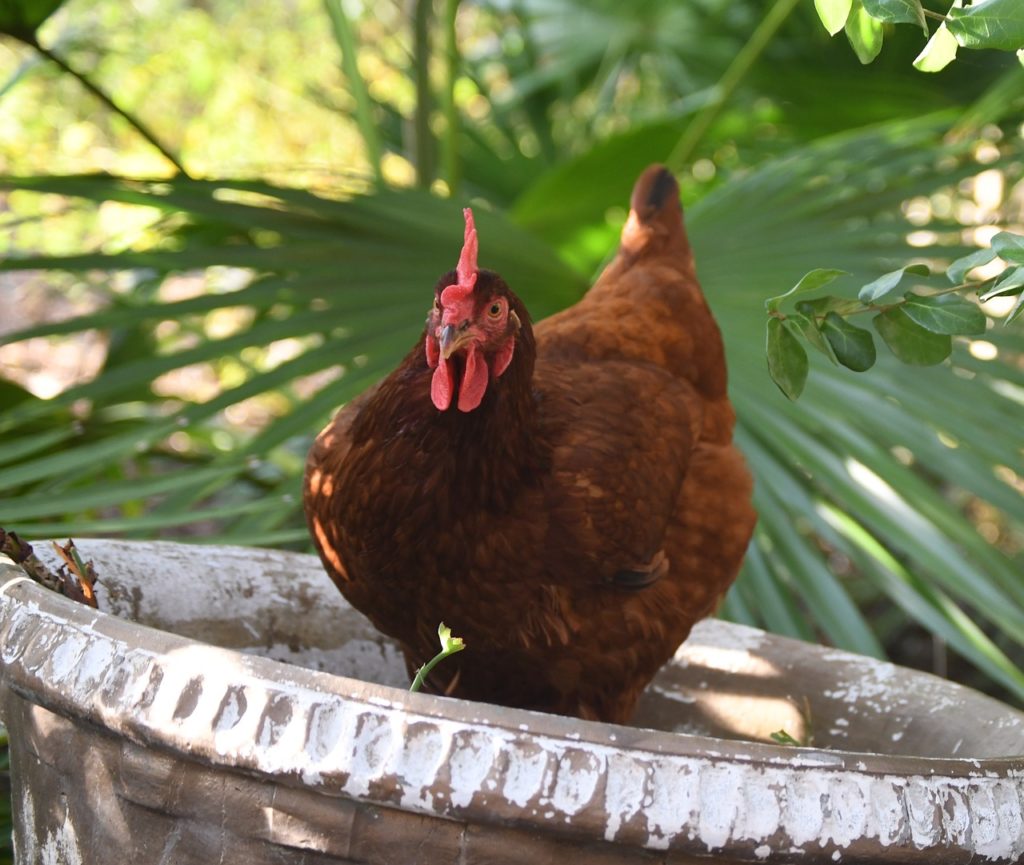
Rhode Isle Reds were originally developed in New England (specifically Massachusetts and Rhode Island – does the proper noun make sense?) so they are well-adjusted to the cold environs of the Northeast.
These birds, which originated in the late 1800s, were officially recognized past the American Poultry Clan in 1904. It's likewise the state bird of Rhode Isle!
Rhode Island Reds are dual-purpose birds, raised for both eggs and meat. Roosters usually weigh in at around eight pounds.
Although they are usually relatively docile and curious, they can be somewhat aggressive or cagey around other birds.
This bird produces an impressive 280 eggs each yr on average, and while its laying may slow or end afterwards the outset iii years of laying (equally well as during the wintertime months), it is otherwise quite common cold hardy species.
It also does well in hot weather condition, making it a skillful bird to consider if you live in an area with extremes at both ends of the spectrum.
two. Plymouth Rocks
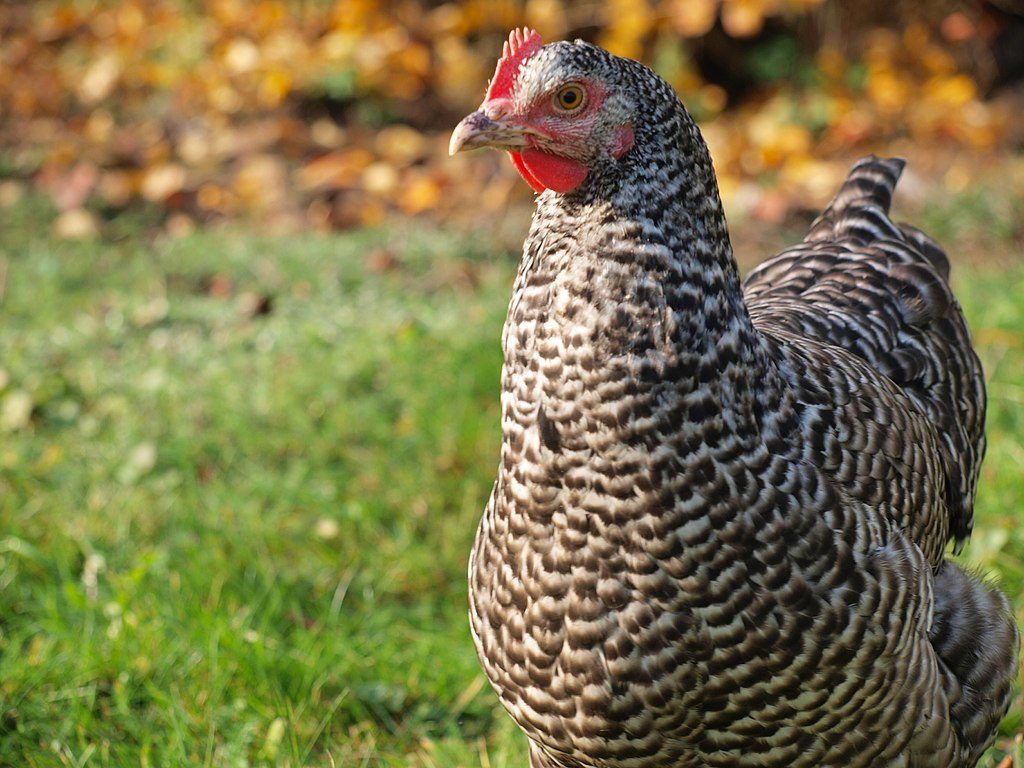
Plymouth Rock chickens were originally adult in the belatedly 1800s, bred in New England as dual purpose birds.
Similar Rhode Island Reds, they can produce well over 250 eggs each year. Roosters weigh effectually viii lbs while hens come in at almost 7 lbs.
They mature quickly and are also quite cold-hardy.
Plymouth Rocks like to free range whenever given the opportunity.
They possess docile demeanor and while the hens occasionally go broody, it's not that common.
They are dependable birds and come up in 7 dissimilar recognized varieties: silver-penciled, Colombia, barred, buff, blue, partridge, and white.
3. Buckeyes
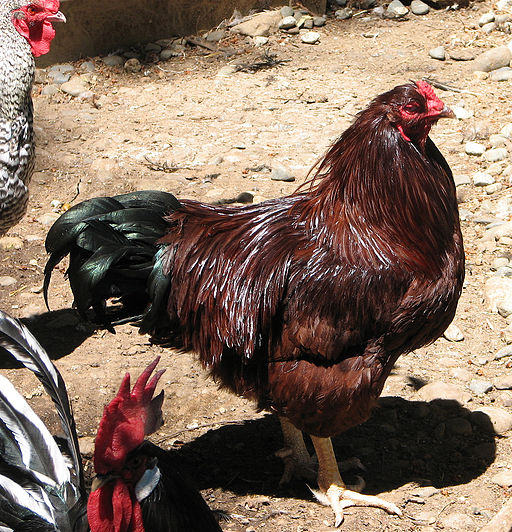
The Buckeye is unique considering it is the only recognized breed that was developed past a adult female.
Adult in the Buckeye land of Ohio, hence the name, these chickens were admitted to eh American Poultry Association in 1904 as a astounding dual purpose breed.
Renowned for their ability to withstand cold temperatures, these birds have small-scale cushion combs and practice quite well when immune to free-range (although they can handle confinement, too).
These chickens are curious and friendly, though roosters can be relatively aggressive.
They aren't as nifty at laying eggs as the concluding ii breeds we mentioned, only they still produce a respectable 150-200 eggs each twelvemonth. Roosters will weigh around 6 or 7 lbs.
4. Welsummers
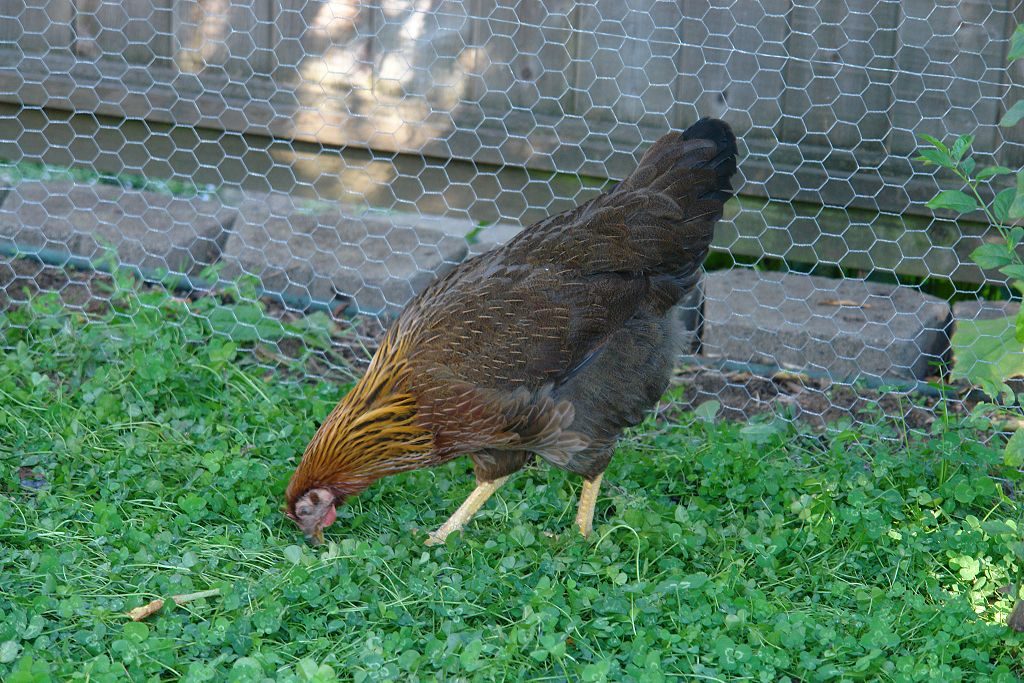
Welsummers are gorgeous chickens that are native to the village of Welsum in holland.
Kickoff brought to the United states of america in the early parts of the twentieth century, this brood is another cracking common cold-hardy, dual-purpose breed.
Roosters by and large counterbalance near vii lbs and hens reach about 6. Although Welsummers are slower to mature than other breeds, they are very hardy and do well in the cold.
Equally agile birds, they are great gratuitous-rangers and get forth well with other birds while also being quite intelligent.
v. New Hampshire Reds
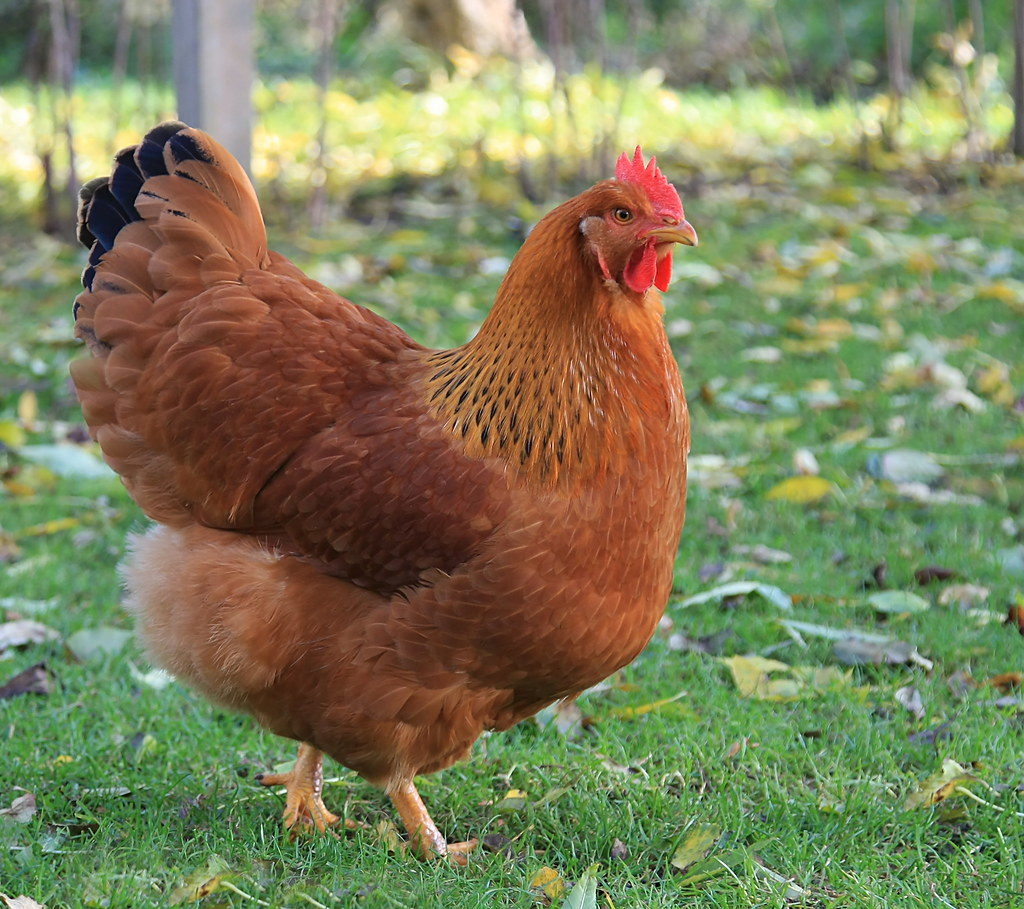
If you thought the Rhode Island Red was a slap-up cold hardy craven breed, wait until you lot hear about the New Hampshire Red!
These chickens are often mistaken for the Rhode Island considering they are close relatives.
However, New Hampshire Reds are quite a bit larger, making them fifty-fifty ameliorate suited for raising in common cold climates.
A dual-purpose brood, the New Hampshire Red is a prolific egg layer and produces roosters that are perfect if you are raising them for meat.
6. Australorps
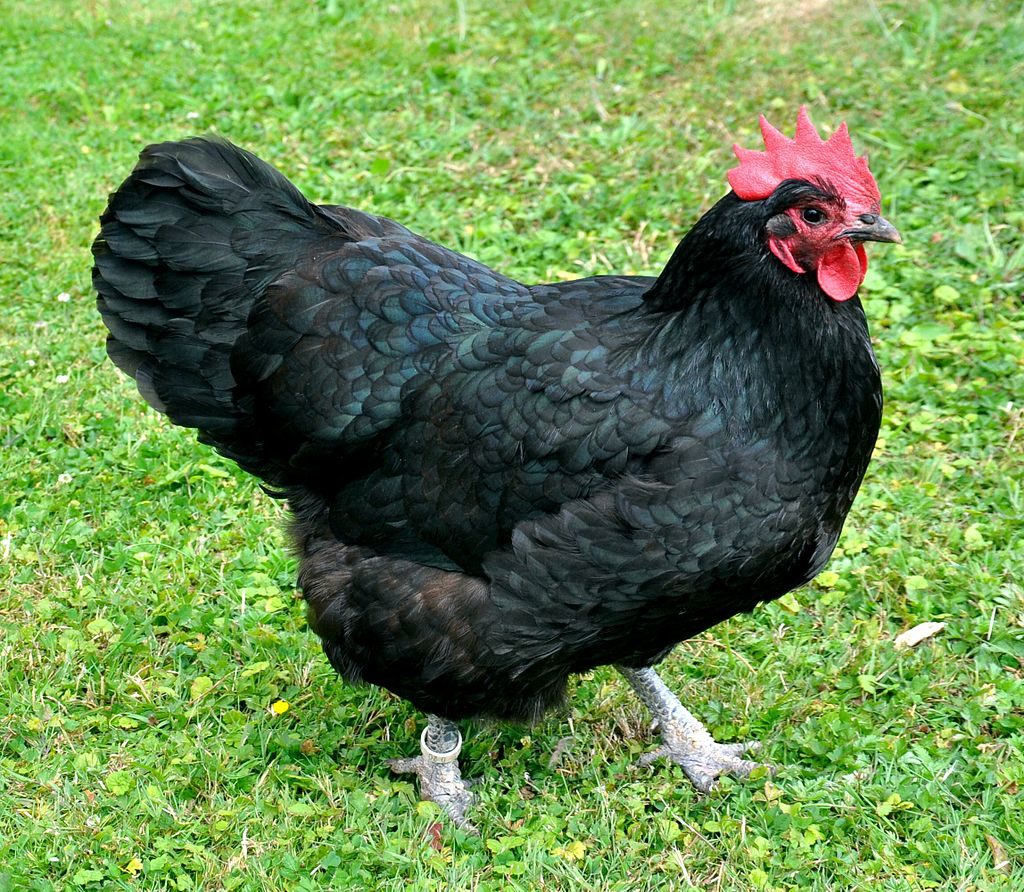
Australorps originated in the 1920s in Australia as a combination of the blackness Orpington and several other breeds.
Today, this excellent dual-purpose bird is a prolific layer of medium-sized brown eggs.
In fact, it's the Australorp that holds the record of the most eggs laid in 1 year – 364 eggs in a unmarried year, in fact.
In add-on, Australorps can be raised for meat.
Roosters tin counterbalance upward to 10 lbs while hens tin reach 9 lbs. Equally with some of the other birds nosotros've mentioned, Australorps mature somewhat slowly.
Even so, they are very cold-hardy and also quite docile. An piece of cake going chicken breed, the Australorp does well in both heat and cold and gets along quite well with children.
vii. Wyandottes
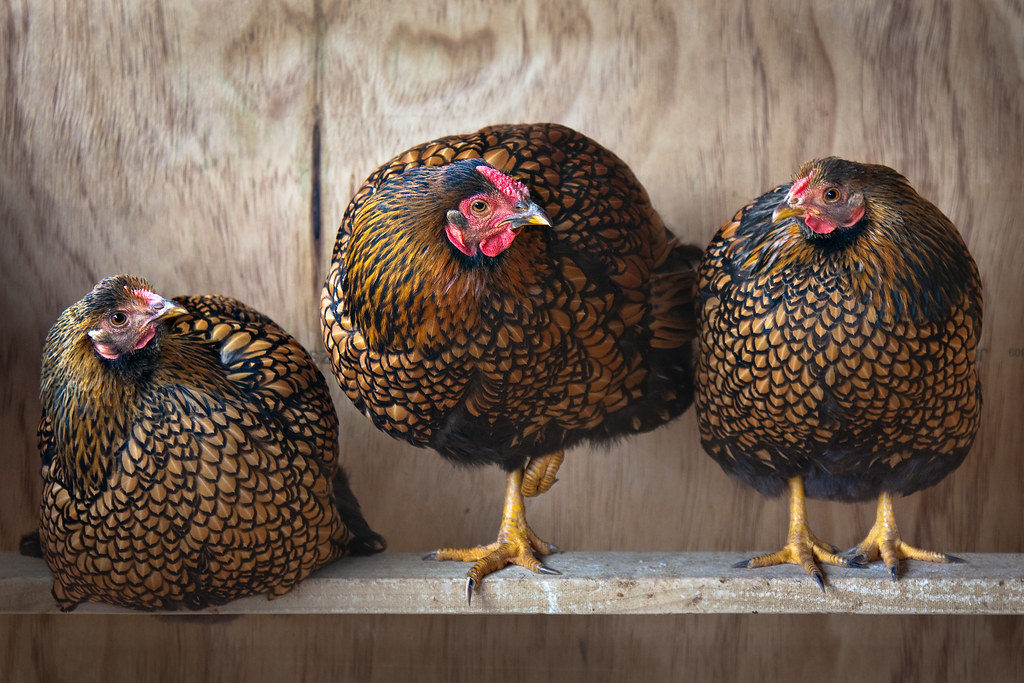
The Wyandotte chicken is another heritage chicken brood that was first showcased in the late 1870s.
This bird was one of the original dual purposes breeds, with hens laying up to 200 eggs each year.
The meat, too, is of exceptional quality. Males will commonly counterbalance around eight lbs while hens volition reach about 6. Docile, calm birds, the hens volition occasionally become broody.
That being said, these chickens are some of the nigh cold hardy.
Virtually hens volition lay all throughout the winter months, and they rarely suffer from frostbite since they have delicate rose combs that tin withstand the cold with exceptional ease.
viii. Dominiques
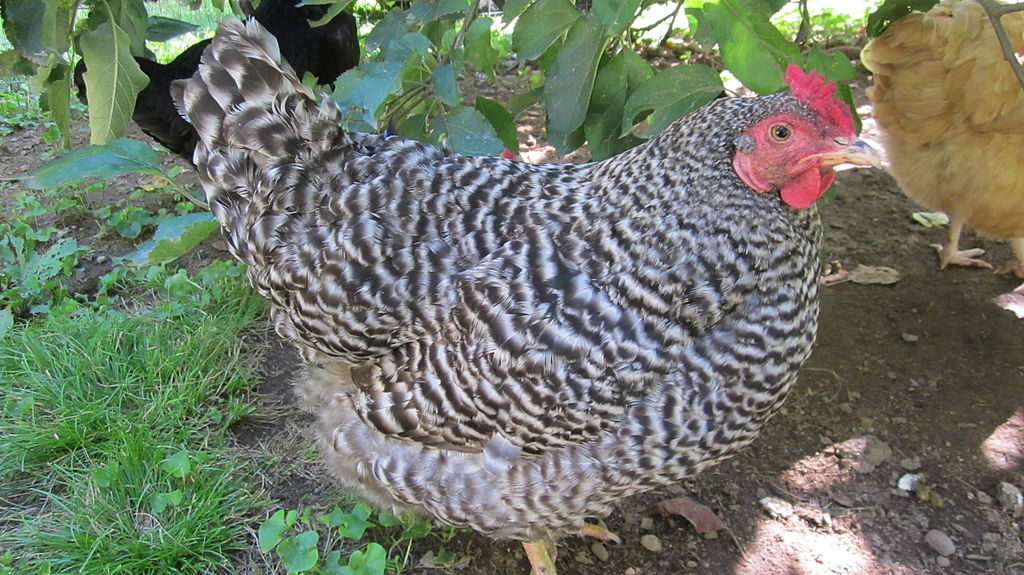
Dominique has the reputation of being the oldest American craven bred.
These chickens were showtime brought to the The states during colonial times by the Pilgrims.
Also known as dominickers and Pilgrim fowl, these chickens are dual purpose birds that are better-known for their egg-laying ability than for their meat production.
On boilerplate, a Dominique hen volition lay effectually 150 to 200 eggs each yr.
Dominiques practice exceptionally well in the cold, possessing small pea combs that make them withstand the cold with grace.
They are quite robust and very good natured.
As well known for being keen mothers, these chickens often get broody and are commonly raised in some of the coldest areas of the world, including Canada and Alaska.
ix. Brahmas
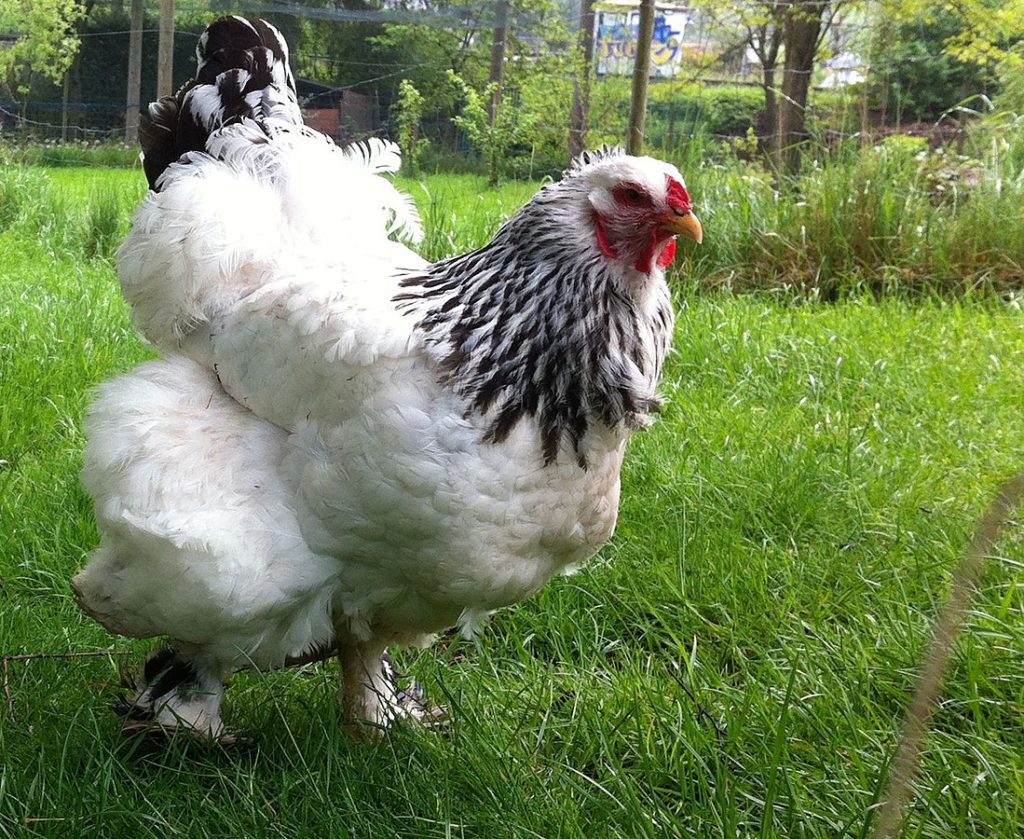
Brahma chickens are large dual purpose breeds that can withstand cold temperatures with ease.
They are one of the few winter-hardy breeds that have feathers not only on their entire bodies, but also on their feet.
These sweetness chickens are ofttimes kept equally pets, and can be kept in just near whatever surface area of the world.
Brahmas come up in a variety of colors including buff, calorie-free, and dark.
They are also oftentimes bred as bantam breeds, but you might want to try out the full-sized standard version before trying a bantam if you live in a cold climate.
10. Vitrify Orpingtons
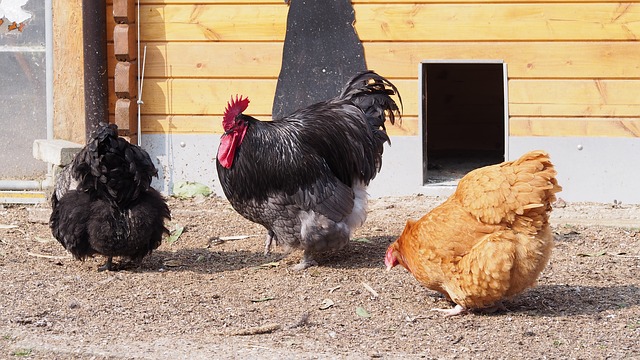
There are several types of Orpington chickens you can raise, including the gorgeous and popular Vitrify Orpington.
These chickens are quite big and take extremely fluffy feather.
They as well accept modest single combs that brand them withstand the cold with ease.
In addition, Orpingtons are first-class layers.
They often go broody and have friendly dispositions that besides brand them excellent parents. They are a top pick for people seeking common cold-hardy craven breeds.
11. Faverolles
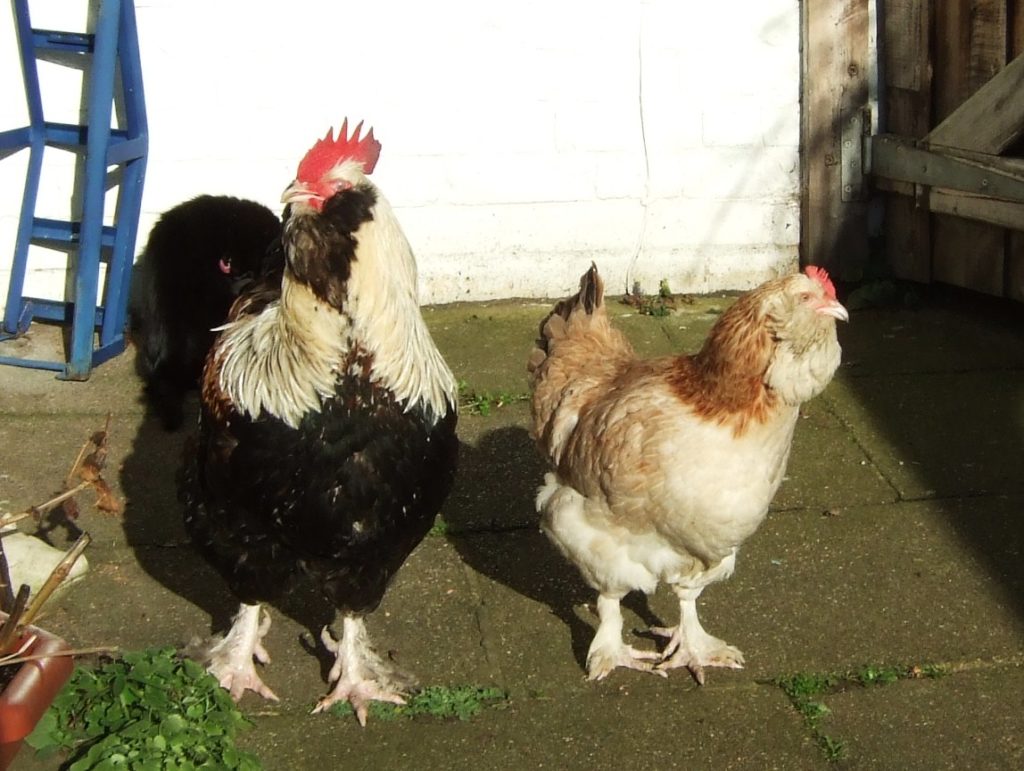
Faverolles were originally bred in French republic every bit meat birds just are now a favorite pet chicken in the United States.
These round, heavy chickens tin weigh up to viii pounds. Their pocket-size combs are close to their heads, helping them retain rut and avert frostbite.
In addition, thy have dumbo, warm feathers, feathered anxiety, cozy beards, and fifty-fifty cheek muffs.
This intense feathering helps keep these birds warm on common cold nights. Faverolles are known for existence friendly and are great for mixed flocks.
12. Ameraucana
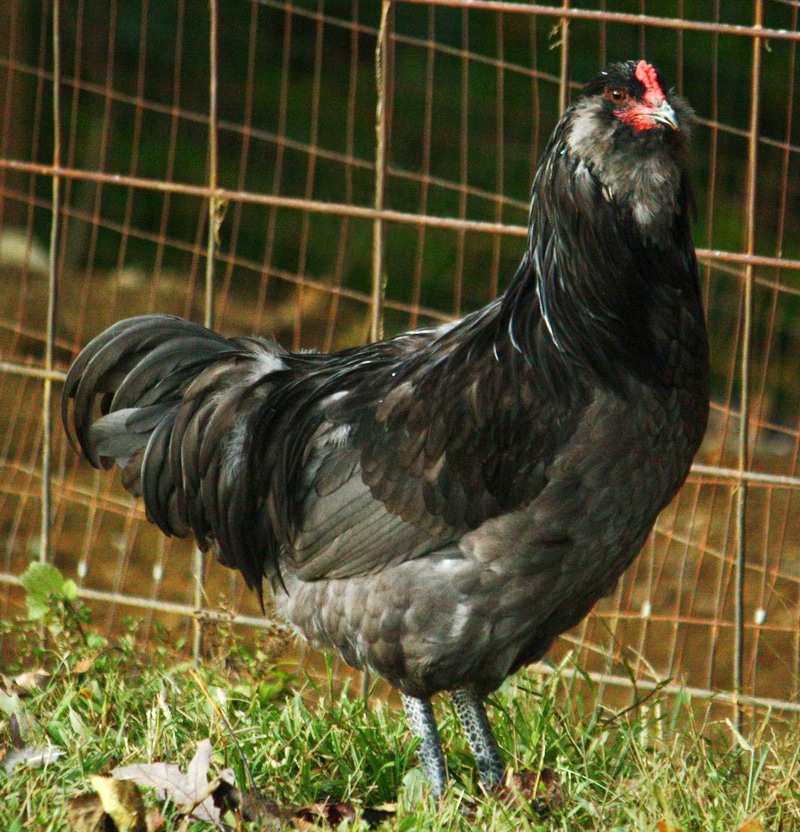
Ameraucana chickens lay gorgeous, medium-sized blue eggs. In fact, many people keep them for this reason alone!
Nevertheless, they are too exceptionally common cold hardy. They have pea combs and tiny wattles, making them less prone to frostbite.
In that location are several varieties of Ameraucanas that you tin can purchase, including blueish, silverish, red, white, black, brown, and buff.
These chickens even accept adorable fiddling feathered beards beneath their beaks!
These don't exercise much to aid keep them warm, but we'd like to call back they add to the wintertime-hardy image of this crawly brood.
thirteen. Chantecler
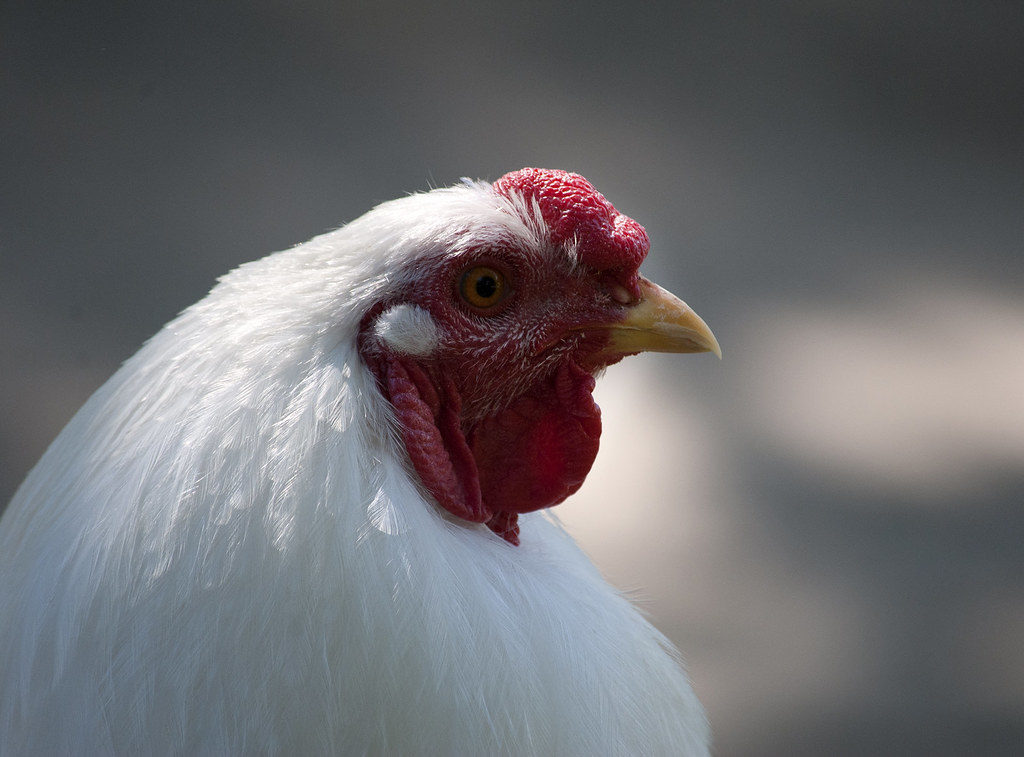
The Chantecler is another acme common cold-hardy chicken breed.
A spunky chicken with a boatload of personality, this chicken often takes place at the acme of the pecking order.
It goes broody frequently and is a wonderful, protective female parent.
It is cold hardy for a diverseness of reasons – non simply does this chicken have a small pea comb, tiny wattles, and a large body, but information technology also is native to Canada.
As a outcome, information technology is i of the most naturally cold-hardy chicken breeds you volition find.
xiv. Cochin
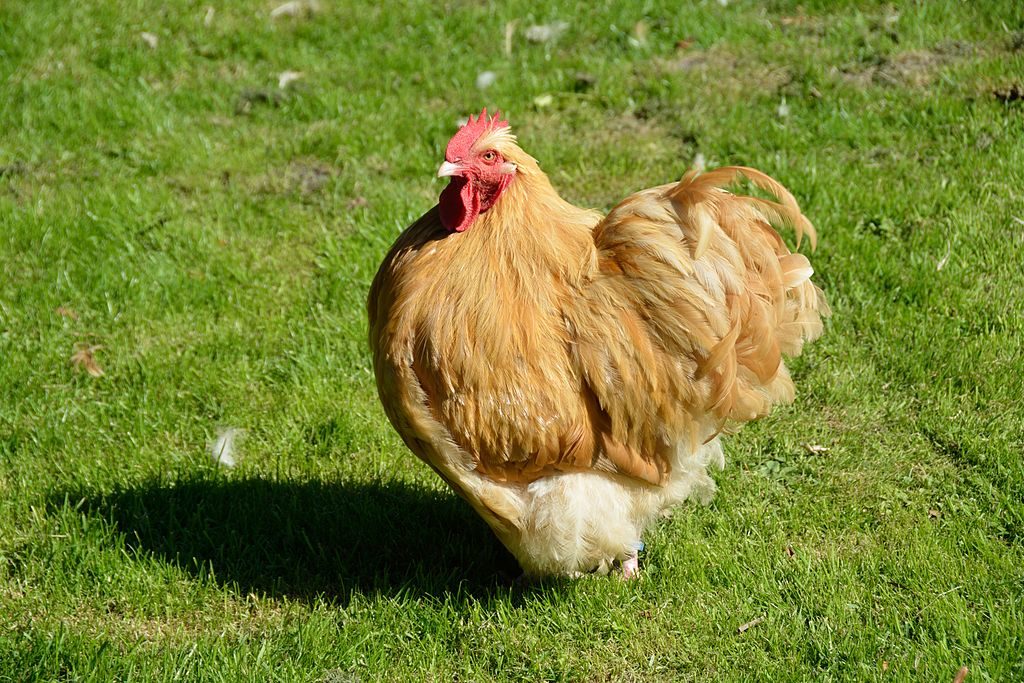
The Cochin chicken is another beautiful breed that does quite well in cold weather condition.
Bachelor in multiple colors, including silver laced, partridge, mottled, blackness, blue, and white, you can purchase this chicken as a frizzled or non-frizzled variety.
Frizzle chickens are less cold hardy than non-frizzled.
Cochins do well in the cold considering they have a small, single comb and dense, warm feathers on their anxiety.
They aren't smashing egg layers, especially in the wintertime, but are groovy chickens to raise if you are looking for a pet craven or one for exhibition.
15. Speckled Sussex
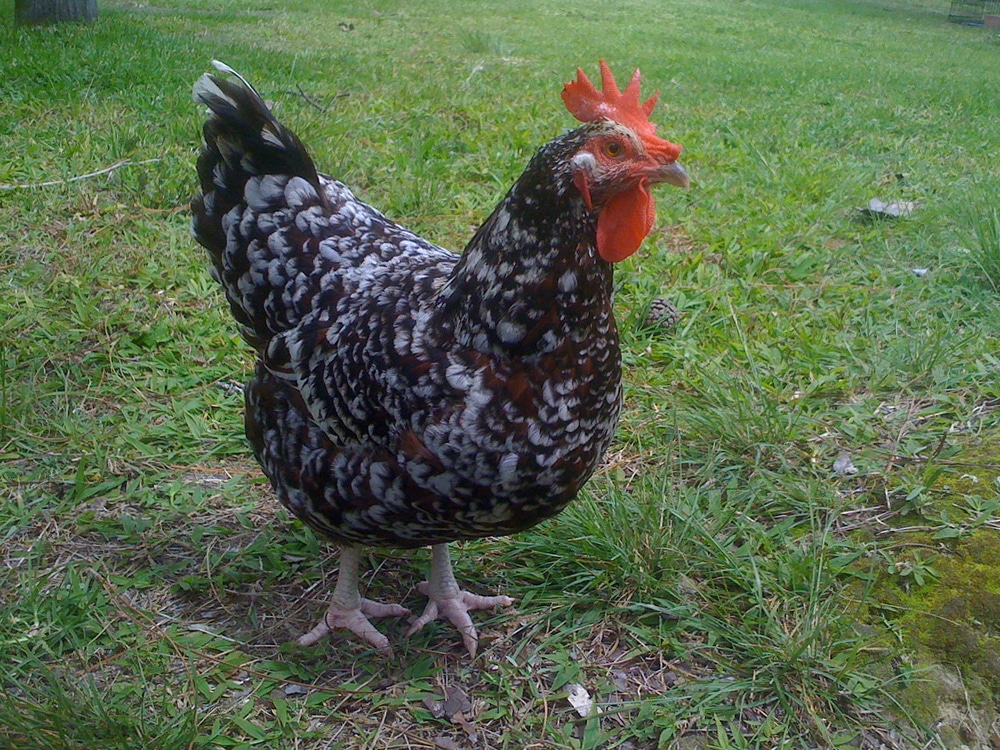
The Speckled Sussex is an excellent layer that is ideal for a cold climate.
Not simply will it lay throughout the entire winter, but it volition produce impressive amounts of eggs during the other seasons of the yr, too.
This craven has a full body that makes it a bang-up dual-purpose brood – and also helps information technology withstand the cold temperatures of the winter.
Tips for Raising Chickens in a Cold Climate
Hither are a few tips for raising chickens during freezing weather:
Prevent Water from Freezing
Chickens always need access to make clean, fresh h2o, but information technology tin can be a real pain to provide this water during the cold winter months, when h2o often freezes in a flash.
You can sue a heated waterer to preclude you from having to constantly truck water out to the coop.
Offer Some Extra Calories
Your chickens volition naturally want some actress calories during the winter.
They are going to exist using up extra calories just to stay warm so it'south not a bad thought to offering gratuitous choice feed during the colder months.
Complimentary choice feeding is recommended during the residue of the yr, too, to help your chickens stay happy and healthy, but it'due south essential during this cold season.
You lot can also give your birds some extra treats in the evenings. Await until the evening hours to do this so that your chickens accept consumed all the nutrients they need to stay healthy during the day.
Scratch grain and other treats aren't necessarily nutritionally dense, but they offer additional calories that your chickens will demand to create torso heat in society to digest.
A handful of scratch grain each is a slap-up manner to help your chickens stay warm overnight.
Keep the Bedding Dry out and Clean
It'due south e'er important to go along your coop gratuitous of excess moisture, but it's never more important than in the wintertime.
Moisture can quickly build upwardly from dripping water, urine, and excrement, leading to high levels of ammonia which tin not only impairment the lungs of your chickens but tin also create a damp environment.
Also much h2o increases the likelihood of frostbite.
If cleaning your coop once a week isn't an selection, another adept method of keeping your chickens warm is through using the deep litter method.
This method of bedding your coop involves allowing bedding material and poop to build up throughout the twelvemonth so that past winter, you have most a foot of composting material on the coop floor.
The compost itself will permit your eye, and y'all won't have to worry about your chickens getting as well cold.
Winterize the Coop and Run
Your coop needs to exist properly winterized with adequate ventilation – simply not too much! – for your chickens to make it through the season.
The goal here is to create a coop that is not too drafty merely not too stuffy – if it's as well enclosed, moisture won't be able to escape and you'll accept issues with condensation.
Chickens permit out a remarkable amount of moisture as they breathe. Plus, there is moisture in their urine and droppings.
Even the water in your drinking fount can exist evaporated back into the air.
Plan for lots of ventilation well-nigh the top of the coop where the warm, moist air can escape – and position the vents from the roost so the birds don't have cool air blowing on them equally they slumber.
Yous may desire to install a humidity gauge in your coop, too, and aim for readings between twoscore and 70%.
If you live in a windy climate, it might as well behoove yous to set up up windbreaks.
You tin encompass your united nations and coop and the windiest sides past using tarps or heavy plastic.
This volition not only go on blowing snowfall and freezing rain away from your flock, but it will also assist warm the coop when the sun is out. Just go out some parts open up for adequate ventilation.
Something else you should know is that chicken aren't terribly fond of snow.
If your chickens don't caput out when temperatures plummet and there's a fresh layer of the white stuff on the footing, don't let information technology worry you.
Be Careful with Heat Lamps
Some people put estrus lamps or even heaters in their coops during the winter months.
While you can certainly practice this, you need to be extremely careful, especially if you are using the deep litter method of bedding.
With all that bedding, you are inviting a fire.
Plus, chickens will warm themselves on the coldest nights – as long every bit you have plenty of bird in the coop, you don't need a heater.
Be Vigilant for Signs of Frostbite
Frostbite can easily strike any type of chicken, but it's more likely to affect craven breeds that accept large combs and wattles.
If y'all have these types of birds already, you can easily prevent frostbite from setting in by applying a thick layer of Vaseline to the combs. This will help protect your chickens confronting the cold.
Frostbite occurs when the fluid in cells freeze.
This causes tissue damage or fifty-fifty death. In full general, your chicken is only at risk of becoming frostbitten in its legs, anxiety, wattles, and combs.
That'southward different from humans, who tin can get frostbite only about anywhere. Moisture most often leads to frostbite, and so a coop with plenty of ventilation is key to preventing it.
Don't Exist Surprised if Laying Ceases or Slows
Call up of winter as a natural suspension in your hens' laying cycles.
Some chickens are naturally excellent layers, even during the winter months.
However, some supplemental low-cal may be required if you lot desire to keep yourself in eggs all winter long.
Just proceed in mind that putting a lite in the coop can stress the birds and shorten their overall al ying lifetime.
Don't stress out too much if laying stops or ceases, though – it'south a natural part of a chicken's cycle.
Can You Raise Chickens During the Winter?
If you live in a common cold environment, yous can absolutely still raise chickens during the wintertime months.
In fact, raising chickens all throughout the year is a great way to provide you and your family unit with consistent access to healthy, fresh eggs and meat – and it will likewise make you feel like a full champion when you detect yourself walking out to the chicken coop in the night hours of a winter forenoon to collect eggs!
However, if yous live in a cold environment and want to raise chickens, you lot need to make sure you put the extra work necessary into figuring out the platonic set up-upwards for your birds.
In that location is some extra piece of work involved in keeping chickens throughout the winter months, but if you practice the advisable enquiry and invest in cold-hardy chicken breeds, your workload will exist substantially reduced.
Consider some of these most cold hardy chicken breeds – and stay warm!
Source: https://www.knowyourchickens.com/cold-hardy-chickens/
0 Response to "How Do You Know Your Chickens Are Happy"
Post a Comment